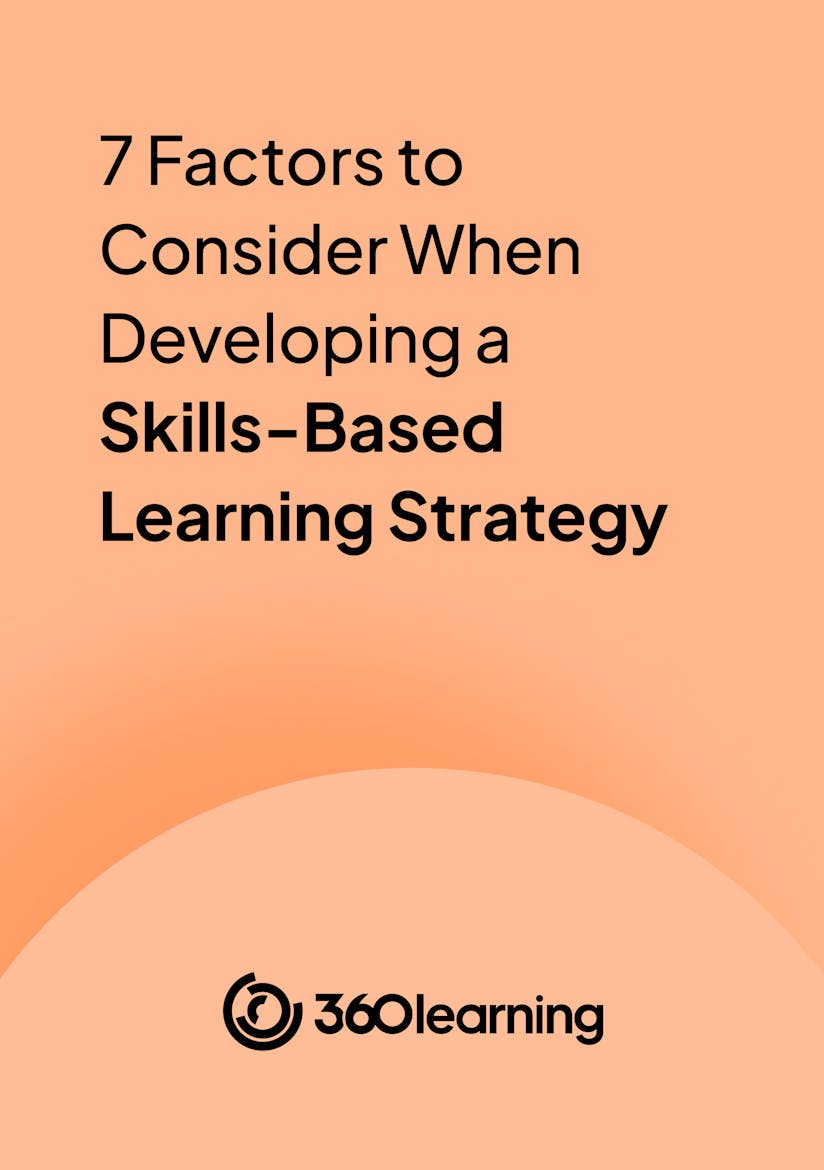Skills-based learning is the response to the skills gaps and shortages experienced across organizations, industries, and even entire economies.
As of 2022, only 10% of organizations adopted skills-based learning to a significant extent. Although that number has certainly increased today, a great majority are still seeking to understand whether it is appropriate for them or are just hesitating because they don’t know what is involved.
In this article, with advice from James Griffin, Principal Consultant at Skill Collective, we discuss the dynamic nature of skills-based learning, how to prepare your L&D team for a skills-based approach, and how to assess the impact of your upskilling interventions.
Listen to our L&D Podcast episode: Implementing Skills-Based Learning With James Griffin

Guarantee a successful move to skills-based L&D
By providing your contact info, you agree to receive communications from 360Learning. You can opt-out at any time. For details, refer to our Privacy Policy.
Skills-based learning empowers more measurable outcomes
Skills-based learning is gaining popularity because measuring outcomes and value is often difficult in more traditional L&D programs.
“Through the use of skills data, skills enable more meaningful and measurable outcomes. I see that as a real benefit to L&D teams,” says James Griffin, Principal Consultant at Skill Collective.
“Through the use of skills data, skills enable more meaningful and measurable outcomes. I see that as a real benefit to L&D teams,” - James Griffin, Principal Consultant at Skill Collective
Typically, L&D teams have leveraged KPI metrics such as course completions and hours spent learning. However, in an uncertain labor market, many organizations are looking to be more adaptable and agile, and measuring whether a learner has logged in and viewed content isn't going to cut it anymore.
Luckily, with the right skills data, L&D teams can provide the data that will empower them to design and deploy more meaningful learning interventions. By understanding the real pain points that your organization needs to solve, skills-based learning can enable you to better measure your business impact.
The dynamic nature of skills
Leveraging a skills-based learning approach can be far more dynamic than competency frameworks, which are typically static.
“Skills, as a dynamic dataset, can provide you with a much more evolving and up-to-date set of data that people can actually buy into,” says James Griffin.
“Skills, as a dynamic dataset, can provide you with a much more evolving and up-to-date set of data that people can actually buy into."
By leveraging skills mapping, you can understand the skills of a role and target your learning interventions for that specific position or audience. You can leverage AI-powered tools to keep your upskilling experiences up to date at a higher cadence than a competency framework.
To make a real impact, ensure that skills are described in natural language so learners can quickly and easily understand what they are trying to develop with clear proficiency levels to empower them to use those skills in their workflow.
Getting ready for skills-based learning
You may find that not everybody is convinced about skills-based learning within your organization.
“So, start by finding the people who advocate for skills, working with them as your early adopters and champions, and drive advocacy from them, getting everybody online as you move forward,” says James Griffin.
“Start by finding the people who advocate for skills, working with them as your early adopters and champions, and drive advocacy from them, getting everybody online as you move forward."
You will find people who know that the status quo is less than desirable, understand the consequences of not changing, and understand how that impacts their current performance levels. You can help them achieve their goals, but better, and from here, you will gain confidence through your approach to making the change and impact required.
A great place to start is where early-stage skills experiments make sense. Consider approaching leaders in the following two functions:
- IT department: Software engineers and data scientists have become increasingly adept at agile methodologies and tend to be receptive to skills-based initiatives.
- Marketing and sales: Their function makes marketing teams typically iterative. They deploy campaigns, measure the outcome, and move on to the next project.
You can also leverage AI tools such as SkillsGPT to improve your skills mapping by creating dictionaries of skills and understanding those skills in your organization’s context.
How to assess the impact of skills-based learning
Various methods exist for assessing your upskilling interventions, such as peer reviews or AI solutions like videos that evaluate an individual against specific criteria.
However, the most impactful method is assessing learners in their work. If employees perform well in their roles, their skills are also at the required proficiency level.
If you have defined the skills and proficiencies in easy-to-understand, natural language, along with clear proficiency levels, your learning interventions will resemble the tasks and outcomes expected in the role.
“So, if you want to assess somebody well, you should be assessing them in the work they are doing. Try to bring that into a process where they are assessed more naturally within the deliverables that they are measured by,” James Griffin.
Quick tips for starting your skills-based learning journey
Start by reaching out to someone within your organization with whom you have a good relationship and build on that foundation.
Collaborate with them on solving the biggest problem stopping them from reaching their objectives. Identify how they measure their business impact. Then, look at how you and your team can solve this business problem.
When beginning your skills-based learning journey:
- Start small.
- Be realistic.
- Prove and validate.
- Plan your next step.
- Don’t let perfection be the enemy of progress.
- Don’t be afraid to fail and learn.
“And don’t view the technology as the entire solution. It is not the silver bullet. It is the enabler. The solution is everything wrapped around it: the policy, process, and people,” James Griffin.
Explore further insights on skills-based learning in the episode on The L&D Podcast: Implementing Skills-Based Learning With James Griffin.
Want more peer insights on transforming workplace learning? Sign up to become a member of the L&D Collective. Or you can subscribe below to our weekly newsletter to receive our latest posts directly in your inbox.


